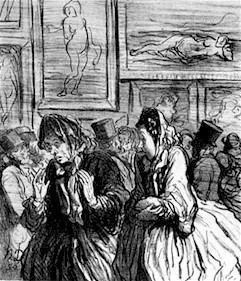Salon (Paris)


The Salon (French: [Salon] Error: {{Lang}}: text has italic markup (help)), or rarely Paris Salon (French: Salon de Paris), beginning in 1725 was the official art exhibition of the Académie des Beaux-Arts in Paris, France. Between 1748 and 1890 it was the greatest annual or biannual art event in the Western world. At the 1761 Salon, thirty-three painters, nine sculptors, and eleven engravers contributed.[1] From 1881 onward, it has been organized by the Société des Artistes Français. Foobar
Origins[edit]
In 1674, the royally sanctioned French institution of art patronage, the Académie royale de peinture et de sculpture (a division of the Académie des beaux-arts), held its first semi-public art exhibit at the Salon Carré. The Salon's original focus was the display of the work of recent graduates of the École des Beaux-Arts, which was created by Cardinal Mazarin, chief minister of France, in 1648. Exhibition at the Salon de Paris was essential for any artist to achieve success in France for at least the next 200 years. Exhibition in the Salon marked a sign of royal favor.
In 1725, the Salon was held in the Palace of the Louvre, when it became known as Salon or Salon de Paris. In 1737, the exhibitions became public and were held, at first, annually, and then biannually in odd number years. They would start on the feast day of St. Louis (25 August) and run for some weeks. Once made regular and public, the Salon's status was "never seriously in doubt" (Crow, 1987). In 1748 a jury of awarded artists was introduced. From this time forward, the influence of the Salon was undisputed.
Prominence (1748–1890)[edit]
The Salon exhibited paintings floor-to-ceiling and on every available inch of space. The jostling of artwork became the subject of many other paintings, including Pietro Antonio Martini's Salon of 1785. Printed catalogues of the Salons are primary documents for art historians. Critical descriptions of the exhibitions published in the gazettes marks the beginning of the modern occupation of art critic.
- ^ Levey, Michael. (1993) Painting and sculpture in France 1700-1789. New Haven: Yale University Press, p. 3. ISBN 0300064942
